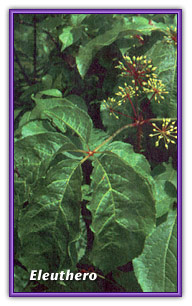Eleuthero
Eleutherococcus senticosus
 Source
Source
Eleuthero, also known as Siberian ginseng, is the root, root bark, or stem
of a shrub in the ginseng family. It grows in thickets in northeast China,
eastern Russia, Korea, and Japan's northern island, Hokkaido. Most of the
supply comes from Siberia and China, but it is also grown in eastern
Europe. The Chinese call it ci-wu-jia.
Traditional Use
Eleuthero has been used in China as a tonic for invigorating vital energy
(qi) for more than 2,000 years. It is listed in the first (most
important) class of herbs in Shen Nong Ben Cao Jing, but some Chinese
scholars question whether Shen Nong actually described eleuthero or
another plant. Its recent use in China derives from Russian research since
the early 1950s. In Chinese medicine, it is used to normalize body
functions, restore vigor, improve health, promote good appetite, and help
to assure a long life. Generally, it serves as a preventive medicine and
general tonic.
Current Status
I. I. Brekhman, the leading Russian researcher on ginseng, has described
eleuthero as an "adaptogen", an innocuous substance that causes minimal
disorders of an organism's function. It must have a "nonspecific action"
that normalizes body functions, no matter what the condition or disease.
Adaptogens are essentially general tonics.
Since the early 1950s, studies have shown that eleuthero extract increases mental alertness, work output, and the quality of work under stressful conditions and in athletic performance. In addition, it strongly stimulates the immune system.
German authorities allow eleuthero to be labeled as an invigorating tonic for fatigue, convalescence, decreased work capacity, or difficulty in concentration.